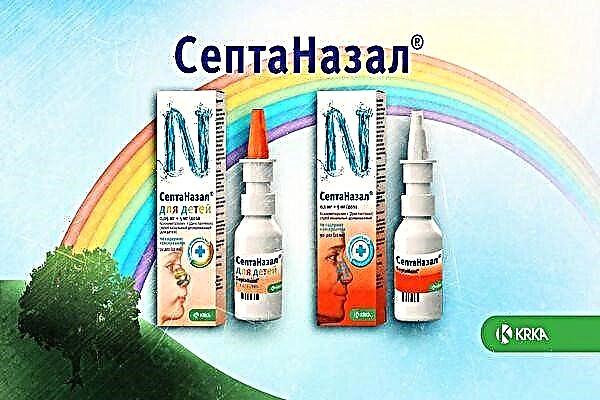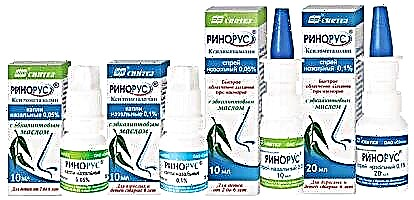From the very beginning of complementary feeding, from about six months, the baby begins to eat healthy food. First, these are vegetables, fruits, then cereals, meat and dairy products. At what age you can give a pomegranate to a child, is it possible to give pomegranate juice to a crumbs even before the onset of a year, how useful is a decoction from the fruit rind, and why its bones are dangerous - these questions are often asked by pediatricians, since mothers want to introduce this fruit into their diet as soon as possible.

The kid shows interest in the grenade
The benefits of pomegranate in baby food
I want to feed my children only high-quality products. Pomegranate is just that, because it brings great benefits to the child's body:
- contains B vitamins, which promote active growth;
- improves the activity of the nervous system;
- increases resistance to disease;
- saturates the body with microelements in a natural way;
- improves the condition of the skin, hair, strengthens nails, teeth and bones;
- increases energy levels;
- source of glucose, replaces store sweets;
- eliminates sore throat, gums during teething.
Important! For children who have problems in the digestive tract, a tendency to allergies, pomegranate should be introduced into food gradually, observing the reaction of the body. In no case should you eat and chew the peel, it is used to prepare medicinal decoctions.
The nutritional value of the fruit
The fruit contains a number of substances useful and nutritious for the body:
- Vitamin C, which protects against colds, strengthens the immune system. Also, this element balances the work of the endocrine, nervous systems and participates in metabolic processes;
- Vitamins of group "B", thanks to which the body fully develops: the central nervous system is formed, protein metabolism is accelerated;
- Potassium and phosphorus form strong bones, with their help the water balance is normalized;
- Iron helps in the process of anemia;
- Pomegranate is a powerful antioxidant that protects the body from harmful substances.
How to choose the right fruit
When choosing a fruit, you should pay attention to its external characteristics. A bright, red, shiny sample cannot be taken - it has not yet matured. A ripe product usually has a firm skin with tubercles, an uneven color without green spots. The grains should be red or scarlet.

Unripe fruit
Ripe fruit should not be soft. There is no specific smell.
Note! Brown grains are evidence of running fermentation processes. You cannot buy such fruits.
Is it possible to give pomegranates to a child a year
Is it possible for a pomegranate for a one-year-old child - undesirable. The fruit itself should be introduced into food only when the baby understands what to do with the bones. This is usually 2.5-3 years old.
Important! If the crumb eats food only in the form of mashed potatoes, and when a solid piece gets into the mouth, a gag reflex occurs, in no case should you give pomegranate.
In a year, the baby still has very few teeth, it is difficult to chew, so he can swallow the kernels without chewing. It is very dangerous.
When to add juice to food
The product can be administered from 10 months only as a juice. It is important to buy the sweet variety. The first sample is juice diluted with water, 1: 2.
In the first half of the day, it is worth giving one teaspoon, then during the day, track whether there will be a reaction. In the absence of it, the dosage is increased, you can gradually switch to the undiluted version.
Sour varieties are offered to a child after the age of seven. You cannot add sugar to them - acids in combination with them will adversely affect the gastric mucosa.

Freshly squeezed pomegranate juice
Additional Information. Evgeny Komarovsky, a Russian pediatrician, recommends diluting pomegranate juice by half with water for up to seven years. You can give it 1-2 times a week, from two years old - no more than 100 ml, by 5-6 years - 200 ml at a time, after seven years - 400 ml, but no more than twice a week.
Is it possible to give a pomegranate with seeds
Today a new seedless pomegranate variety has been developed, but it is problematic to get it. If this did not work out, then you should carefully monitor so that the baby does not swallow the kernels whole and does not eat too much.

Seedless pomegranate variety
When can you safely give your child pomegranate with seeds? All pediatricians agree that no earlier than three years, some varieties are offered no earlier than seven years. Be sure to keep track of how much the baby eats. Even if he likes the fruit, he shouldn't eat it in unlimited quantities.
Rules:
- After three years - no more than a quarter of the fruit;
- After four - half a pomegranate 1-2 times a week;
- After seven - 2 grenades per week are permissible.
The danger of developing appendicitis
If the child did not spit out the bones, you should not worry that this will cause inflammation of the appendix. This fact has long been disproved. Intestinal obstruction is more likely to occur than appendicitis.
Important! In small quantities, the eaten bones will be excreted with feces, without causing anxiety to the baby.
How to make pomegranate juice
The juice is made using a citrus press. First, the pomegranate is cut into two halves, and the juice is squeezed out of it using a press.
Note! You should not squeeze juice through an electric juicer - there will be too much cake, and a small amount of juice.

Making pomegranate juice at home
There is another option for obtaining a product - manual. The fruit is kneaded with your fingers, you can roll it on the table with effort. As a result, the kernels inside will be crushed, you just have to make a hole, and the juice will be in the glass.
Additional Information. You can make it even easier if you peel the fruit and put the grains in a sieve. Then press them with a crush. The juice that will drain, then strain through cheesecloth.
Juice rates for feeding
The juice must be diluted with boiled water 1: 2 and given to the baby no more than twice a week. At first he tries 1 teaspoon, if this did not cause any consequences in digestion, the dosage is gradually added to 100 ml. From the age of seven, you can give up to 400 ml of juice. The child can also eat the pulp of the fruit no more than twice a week.
Possible problems
Pomegranate has a positive effect on the body. But it can do harm:
- Allergy occurs. It may be a red rash, itching, so the fruit should be excluded from the diet for a while;
- Pain in the stomach, indigestion in the form of diarrhea and subsequent dehydration. Since the fetus contains a lot of acid, it can impair the functioning of the digestive tract;
- Oxaluria. Children with urolithiasis should not be given pomegranates;
- Sensitive tooth enamel, its destruction. The acid has a negative effect on the enamel, so the juice should be offered diluted. You can offer your baby a tube so that the drink is less in contact with the teeth.
Signs of allergies
Because pomegranate has rich pigments, like many red fruits, it is a potential allergen. Despite the fact that it contains a large amount of nutrients, it should be offered to a child with great care.

Allergic reaction in a child
As a rule, allergies appear several hours after eating the fruit. She may be:
- A small, itchy rash;
- In the form of vomiting, runny nose, cough, conjunctivitis.
If a reaction occurs, it is necessary to immediately stop using the fetus and consult a doctor. Pomegranate is a fruit rich in vitamins that should definitely be included in a child's diet. This should be done carefully - in this case, there will be no negative consequences.



